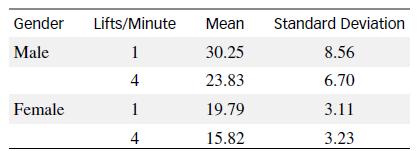Engineers have a team for unaided human acts of lifting, lowering, pushing, pulling, carrying, or holding and
Question:
Engineers have a team for unaided human acts of lifting, lowering, pushing, pulling, carrying, or holding and releasing an object—manual materials handling activities (MMHA). M. M. Ayoub, et al. (1980) have attempted to develop strength and capacity guidelines for MMHA. The authors point out that a clear distinction between strength and capacity must be made: “Strength implies what a person can do in a single attempt, whereas capacity implies what a person can do for an extended period of time. Lifting strength, for example, determines the amount that can be lifted at frequent intervals.” The accompanying table presents a portion of the recommendations of Ayoub, et al. for the lifting capacities of males and females. It gives the means and standard deviations of the maximum weight (in kilograms) of a box 30 centimeters wide that can be safely lifted from the floor to knuckle height at two different lift rates—1 lift per minute and 4 lifts per minute.

a. Roughly sketch the relative frequency distribution of maximum recommended weight of lift for each of the four gender/lifts-per-minute combinations. The Empirical Rule will help you do this.
b. Construct the interval for each of the four data sets and give the approximate proportion of measurements that fall within the interval.
c. Assuming the MMHA recommendations of Ayoub et al. are reasonable, would you expect that an average male could safely lift a box (30 centimeters wide) weighing 25 kilograms from the floor to knuckle height at a rate of 4 lifts per minute? An average female? Explain
Step by Step Answer:

Statistics For Engineering And The Sciences
ISBN: 9781498728850
6th Edition
Authors: William M. Mendenhall, Terry L. Sincich





